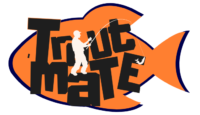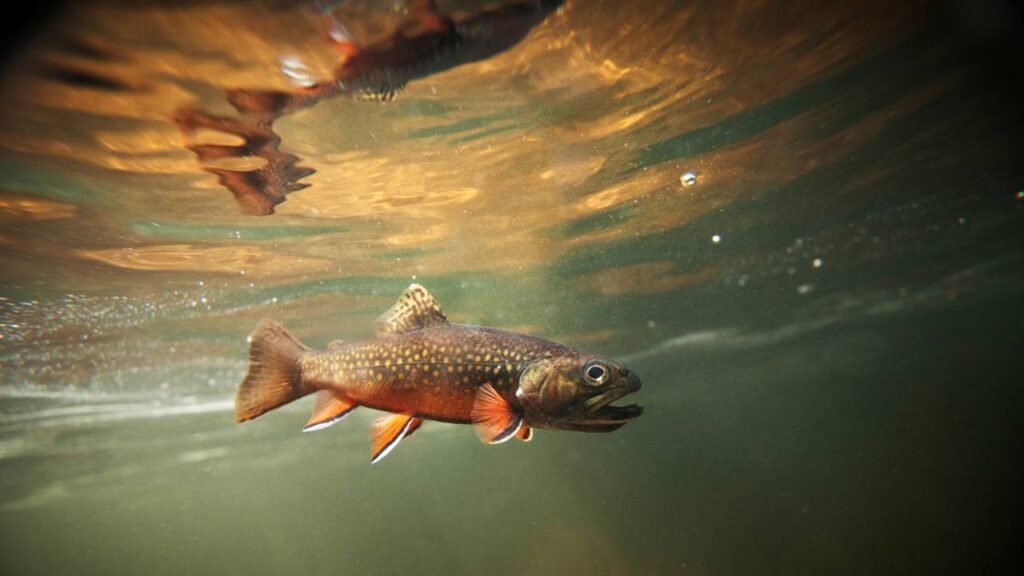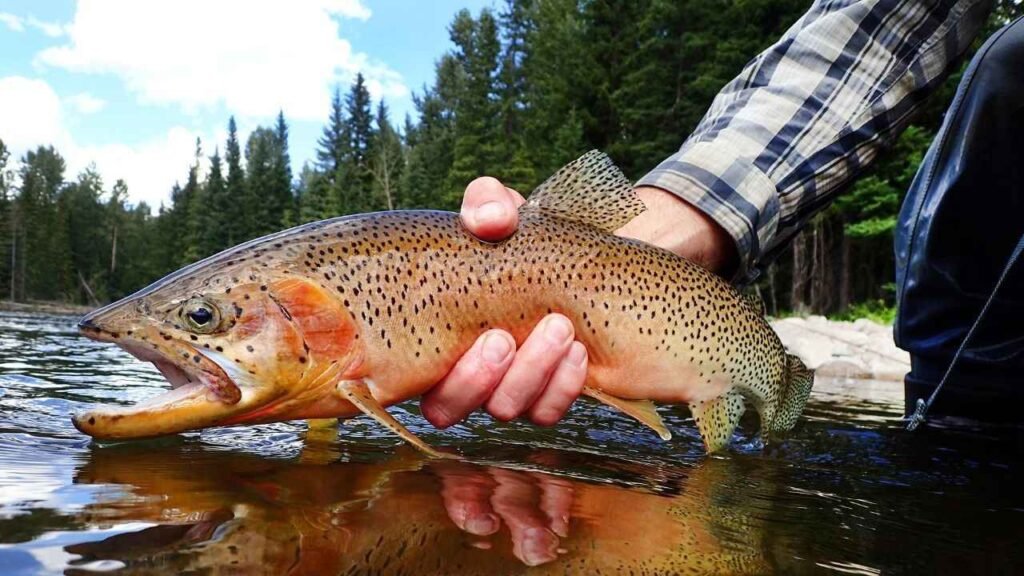The best way to trout fish is by using lightweight tackle and natural bait. Fly fishing is also highly effective.
Trout fishing offers an exciting outdoor experience and requires specific techniques for success. Lightweight tackle helps in presenting the bait more naturally, increasing your chances of a catch. Natural bait like worms or insects often attract trout better than artificial lures.
Fly fishing, a popular method, mimics the appearance of insects on the water surface, enticing trout to strike. Early mornings or late evenings are ideal times for fishing since trout are more active. Understanding the behavior and habitat of trout can significantly improve your fishing skills. Whether you’re a beginner or an experienced angler, these strategies can make your trout fishing adventure more rewarding.
Choosing The Right Gear
Trout fishing is an exciting outdoor activity. Choosing the right gear is crucial for a successful trip. The right gear can make the difference between a great catch and a disappointing day. This section will guide you on selecting the best gear for trout fishing.
Rods And Reels
The rod and reel are your primary tools. A lightweight rod is ideal for trout fishing. It should be around 6 to 7 feet long. A fast-action rod helps with better casting and control. Choose a spinning reel that complements the rod. It should be smooth and easy to handle. A good drag system is essential for reeling in trout without breaking the line.
Key points for rods and reels:
- Lightweight rod (6-7 feet)
- Fast-action rod
- Smooth spinning reel
- Good drag system
Fishing Line
The rod and reel are your primary tools. A lightweight rod is ideal for trout fishing, and it should be around 6 to 7 feet long. A fast-action rod helps with better casting and control. Choose a spinning reel that complements the rod. It should be smooth and easy to handle. A good drag system is essential for reeling in trout without breaking the line. Understanding the braided and monofilament difference and the monofilament and fluorocarbon difference will help you choose the best line to pair with your rod and reel for a successful fishing experience.
Types of fishing lines:
- Monofilament: Versatile and easy to use
- Fluorocarbon: Invisible underwater, best for clear waters
- Braided: Strong and sensitive, but more visible
| Type | Advantages | Disadvantages |
|---|---|---|
| Monofilament | Versatile, easy to use | Less sensitive, stretches |
| Fluorocarbon | Invisible underwater | More expensive |
| Braided | Strong, sensitive | More visible |
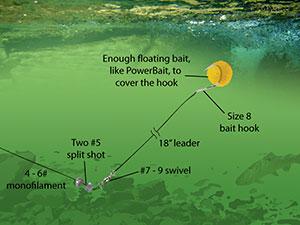
Credit: myodfw.com
Selecting The Best Baits
Finding the best baits for trout fishing is essential. The right bait can make your fishing trip successful. Each type of bait has its advantages. This section will discuss Live Baits and Artificial Lures. By the end, you’ll know which bait to use in different conditions.
Live Baits
Live baits are excellent for catching trout. They mimic the natural diet of trout. Let’s explore some of the best live baits:
- Worms: Earthworms and nightcrawlers are very effective. They attract trout easily.
- Crickets: These are great for fly fishing. They mimic insects trout eat.
- Minnows: Small fish like minnows work wonders. They resemble the trout’s natural prey.
Artificial Lures
Artificial lures are versatile and convenient. They come in many shapes, sizes, and colors. Here are some popular choices:
- Spinners: These lures spin in the water. They create vibrations that attract trout.
- Spoons: Spoons have a wobbling motion. This mimics the movement of injured fish.
- Soft Plastics: These lures imitate small fish or insects. They are flexible and realistic.
Below is a table comparing live baits and artificial lures:
| Bait Type | Advantages | Disadvantages |
|---|---|---|
| Live Baits | Natural appearance, high attraction | Can be messy, require proper storage |
| Artificial Lures | Easy to store, reusable | May require skill to use effectively |
Both live baits and artificial lures have their place in trout fishing. Choose the bait that suits your needs and conditions. Happy fishing!
Understanding Trout Behavior
To excel at trout fishing, one must first understand trout behavior. Knowing their habits, feeding patterns, and seasonal movements can greatly improve your success. Let’s dive into these aspects to become better at trout fishing.
Feeding Habits
Trout are opportunistic feeders and their diet varies. They primarily consume insects, smaller fish, and crustaceans. Understanding their feeding times can be crucial.
- Morning and Evening: Trout feed actively during these times.
- Midday: Less active due to warmer water temperatures.
- Night: Some species feed more actively at night.
Using lures or bait that mimic their natural food can increase your catch rate.
Seasonal Patterns
Trout behavior changes with the seasons. Adjusting your fishing strategies accordingly can yield better results.
| Season | Behavior | Best Fishing Times |
|---|---|---|
| Spring | Trout are active after winter. They move to shallower waters. | Late morning to early afternoon. |
| Summer | Seek cooler, deeper waters. Early morning and late evening are best. | Early morning and late evening. |
| Fall | Active feeding to prepare for winter. They are more aggressive. | Throughout the day. |
| Winter | Less active, prefer deeper, stable temperatures. | Midday when water is warmest. |
Adjusting your approach based on these patterns ensures better results.
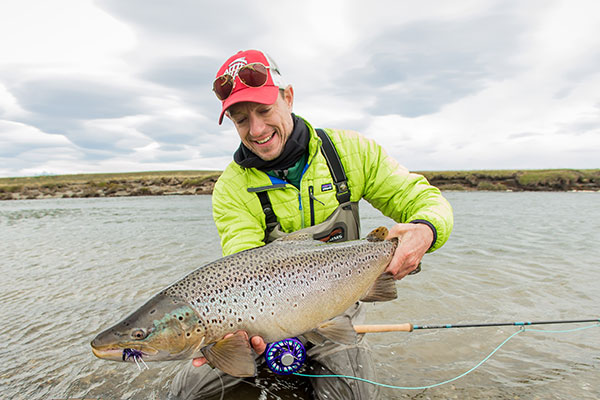
Credit: www.flyfisherman.com
Ideal Fishing Locations
Finding the right spot is key to a successful trout fishing trip. Whether you prefer the flowing waters of rivers and streams or the calmness of lakes and ponds, knowing where to fish can make all the difference.
Rivers And Streams
Rivers and streams offer dynamic environments for trout fishing. The moving water brings a continuous supply of food, making it an ideal habitat for trout.
- Look for deep pools and riffles.
- Trout hide in shaded areas and underwater structures like rocks and logs.
- Early morning and late evening are the best times to fish.
| River Name | Location |
|---|---|
| Madison River | Montana |
| White River | Arkansas |
Lakes And Ponds
Lakes and ponds offer a different experience. The still waters require different strategies to catch trout.
- Focus on shorelines and drop-offs where trout gather.
- Use spinners and spoons for better results.
- Afternoon and early evening are great times for lake fishing.
| Lake Name | Location |
|---|---|
| Lake Tahoe | California/Nevada |
| Big Bear Lake | California |
Effective Casting Techniques
Mastering effective casting techniques is key to successful trout fishing. Proper casting ensures your bait or fly lands where trout are likely to be. Good casting also helps avoid obstacles and reduces the risk of spooking fish.
Overhead Cast
The overhead cast is a fundamental technique in trout fishing. It is simple yet effective for distance and accuracy. Follow these steps for a perfect overhead cast:
- Stand with your feet shoulder-width apart.
- Grip the rod with your dominant hand.
- Raise the rod to the 1 o’clock position.
- Flick the rod forward to the 10 o’clock position.
- Release the line as the rod moves forward.
Ensure you maintain a smooth, fluid motion. Avoid jerky movements for a more accurate cast.
Roll Cast
The roll cast is ideal for tight spaces with limited backcasting room. It is also effective in windy conditions. Follow these steps to perform a roll cast:
- Stand with your feet shoulder-width apart.
- Grip the rod with your dominant hand.
- Let the line float on the water surface.
- Raise the rod tip to create a loop behind you.
- Push the rod forward, rolling the line off the water.
The roll cast is less likely to spook fish. It is also great for short to medium distances.
Both casting techniques are essential for a versatile angler. Practice them to improve your trout fishing success.
Reading The Water
Reading the water is key to successful trout fishing. Understanding the water’s behavior helps you locate fish. Let’s explore crucial aspects like current and flow, and water temperature.
Current And Flow
The current and flow of a river affect trout behavior. Trout prefer areas where they can conserve energy. Look for slower currents behind rocks or near the riverbank.
Use this table to identify prime fishing spots:
| Water Feature | Trout Behavior |
|---|---|
| Pools | Resting |
| Riffles | Feeding |
| Eddies | Hiding |
Water Temperature
Water temperature plays a crucial role in trout fishing. Trout thrive in cooler waters, usually between 50-60°F. Warmer water stresses trout, making them less active.
Check the water temperature with a thermometer. If it’s too warm, try fishing early in the morning or late in the evening when the water is cooler.
Remember these tips:
- Fish deeper waters in warm weather.
- Look for shaded areas to find cooler water.
- Avoid fishing during the hottest part of the day.
Best Times To Fish
Fishing for trout can be a thrilling experience. To increase your success, it’s essential to know the best times to fish. Trout are more active during specific parts of the day. This guide will help you understand the optimal times to catch more trout.
Early Morning
Early morning is an excellent time to fish for trout. The water is cool, and trout are more active. The best time is usually between 5 AM and 9 AM. During this period, trout tend to feed near the surface. This makes them easier to catch.
Using lures that mimic insects can be very effective in the morning. Here are some tips:
- Use light-colored lures.
- Cast near the shorelines.
- Keep your movements quiet.
Late Evening
Late evening is another prime time for trout fishing. The water begins to cool down again, prompting trout to feed. The ideal time frame is between 6 PM and 9 PM.
During the evening, trout often come closer to the shore. This makes it easier for anglers to reach them. Here are some useful tips:
- Use darker lures.
- Focus on shaded areas.
- Be patient and observant.
The table below summarizes the best fishing times:
| Time of Day | Activity Level | Best Lures |
|---|---|---|
| Early Morning (5 AM – 9 AM) | High | Light-colored lures |
| Late Evening (6 PM – 9 PM) | High | Darker lures |
Catch And Release Practices
Practicing catch and release is crucial for maintaining healthy trout populations. By following proper techniques, anglers can ensure that trout survive after being released back into the water. Here, we discuss the best practices for handling trout and using barbless hooks to enhance their survival rates.
Handling Trout
Proper handling of trout is essential for their survival. Follow these steps:
- Wet your hands before touching the trout. This protects their delicate slime coating.
- Use a rubberized net to minimize injury to the fish.
- Avoid squeezing the trout. Hold it gently but firmly.
- Keep the fish in the water as much as possible. This helps them breathe.
- Remove the hook quickly and carefully. Use pliers if necessary.
Using Barbless Hooks
Barbless hooks make release easier and reduce harm to trout. Benefits include:
| Benefit | Description |
|---|---|
| Less Damage | Barbless hooks cause fewer injuries to the trout’s mouth. |
| Quick Release | Removing barbless hooks is faster, reducing time out of water. |
| Improved Survival | Trout have a higher chance of survival after release. |
To use barbless hooks, follow these tips:
- Purchase barbless hooks from your local tackle shop.
- Or, flatten the barbs on regular hooks with pliers.
- Check your hooks regularly. Ensure they remain barbless.
By adhering to these catch and release practices, you contribute to the conservation of trout populations. Enjoy your fishing experience while protecting these beautiful creatures.

Credit: m.youtube.com
Mastering trout fishing requires practice, patience, and the right techniques. Equip yourself with quality gear and choose prime fishing spots. Understanding trout behavior enhances your chances of success. Keep learning and refining your skills to enjoy a fruitful trout fishing experience.
Happy fishing and may your next catch be your best one yet!
FAQs:
What Is The Trick To Catching Trout?
Use light tackle and small lures or live bait. Fish during early morning or late evening. Target areas with cover like rocks or vegetation. Adjust depth based on water temperature. Keep movements slow and natural.
What Is The Best Bait For Trout?
The best bait for trout includes worms, minnows, and insects. PowerBait and spinners also work well. Experiment with different options.
What’s The Best Rig For Trout Fishing?
The best rig for trout fishing is the slip sinker rig. It includes a light line, small hook, and a sliding sinker. This setup allows for better sensitivity and natural bait movement, increasing your chances of catching trout.
How Do You Trout Fish For Beginners?
Start by choosing a lightweight rod and reel. Use live bait like worms or artificial lures. Fish in clear, cold waters. Cast near structures like rocks or logs. Be patient and stay quiet.
